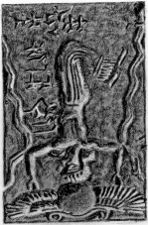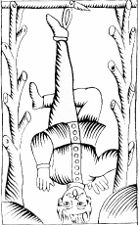


The images on the Marseille Tarot cards started out as illustrations
of Sumero-Bablyonian myths, preserved through the centuries on
cylinder seals. They were copied by people who didn't understand
them but who also had access to some form, whether written or
oral, of the wisdom encoded in those myths and in Bible stories.
That wisdom is identical with Sufi teachings as espoused by
teachers like Ibn al 'Arabi, Rumi, and others, including Gurdjieff
and his teachings about the enneagram. The myths and stories
are decoded in this book using the multiple meanings conveyed by
Arabic consonantal word roots and by reference to those doctrines
and to modern discoveries about conditioning and the hemispheric
specialization of the brain. Arabic is the closest existing descendant
of the ancient Protosemitic language. The Kabbalah, long
rumoured to be linked to the Tarot, is shown to come from the
same sources, and originally had eight, not ten, sefiroth. The visual
evidence alone is overwhelming: the mystery of where the Tarot
comes from has been definitively solved.


Thanks go to Jean-Michel David for including an excerpt from this book in the January 2006 edition of the Association For Tarot Studies e-newsletter. I found the excerpt very interesting, and wanted to see what else this author had to say. I also found it interesting that I had just finished a review of the Babylonian Tarot, by Sandra Tabatha Cicero, which is based on the deities and myths of Mesopotamia -- the very territory that Swift is addressing... Swift starts out with the thought that perhaps authors of Tarot books claim that the origin of the Tarot is unknown because they really prefer not to know, as if it is better left a "mystery". He also posits that after reading this book the reader may find it hard to justify the manner in which they are accustomed to using the Tarot. His wry sense of humor is evident from the very beginning of the book... The body of this book is Swift's linking of the imagery in the Marseilles deck to the iconography of ancient Mesopotamian cylinder seals, and he does an excellent job of this. Scans of the Tarot cards and representations of the seals that they are being compared to are thought provoking, to say the least!... There are in-depth discussions of the imagery of the seals, and how it transfers to the Tarot (and it does so remarkably well). Sufi myths are presented in a story-like manner (I read this book in one sitting - it is that interesting!), and there is a great deal of discussion of word derivations, sound-alike words, the alphabet etc. The work of many of the masters is referenced in a knowledgeable manner (masters such as Madam Blavatsky, Idries Shah, Gurdjieff, and many more Sufi writers), and in a manner that is easily understood by those of us who may not have the background that we would like to have on esoteric subjects. Tossed in amongst this mix are such jewels as Madam Blavatsky's belief that the first three sephiroth are actually blinds, and the notation that horns on individuals found on the seals indicate not that they are "devils", but that they are Gods, with multiple horns indicating high ranking gods. While the reader is free to disagree with Swift on any or all of his suppositions, my feeling is that this book at the very least presents ideas for further study, and opens the mind in many ways - not only as to the origins of the Tarot, but as a mini-study in word derivation and usage. I am left with the thought that this material certainly warrants further study, and that the material here has found its time. I should mention here that there is an extensive bibliography, in case the reader does want to do some research of their own... [It is] very much an "Aha!" experience!
Bonnie Cehovet, Aeclectic Tarot website review
[I] feel motivated to express admiration and respect for the wonderful work of research and presentation of these not commonly met subjects.
Ilya S., Tel Aviv
The basic premise looks sound: the pictures on the medieval Marseille tarot cards have never been explained satisfactorily, but they match the images on Archaic cylinder seals too well for coincidence. Nick Swift's investigations into ancient and modern near-Eastern languages underpin some fascinating linguistic detective work. He makes a strong case that the Sumerian seals were part of a mythological wisdom tradition that was still available in some form to the originators of the tarot deck several millennia later. Happily, the research is presented in an engaging and at times amusing style. Mirror of the Free should fascinate everyone from scholars of iconography to readers of Dan Brown. Students of sufism, Kabbalah, Fourth Way and related experiential paths will find it particularly valuable.
Michael Emmans Dean, author The Trials of Homeopathy: Origins, Structure and Development
Thankyou for publishing such an amazing and interesting book.
Deb G., USA
There is no doubt that this book contains some new and highly important information which has not been published previously. His research covers parallels with Gurdjieff's teaching which has been previously documented and also connections with the Ikhwan as-Safa and Ibn Arabi's thought which has been touched on by Idries Shah in The Sufis and Jereer el-Moor in The Occult Tradition of the Tarot in Tangency with Ibn Arabi's Life and Teachings, but it is in the linking of the Tarot depictions and imagery to be found in the Marseille deck to the iconography of ancient Mesopotamian cylinder seals that the work is truly groundbreaking. Consider the following two depictions: ... To keep this brief I'll just pick up on a few points: the Devil motif, the Hanged Man and possible Islamic/Sufi influence on the development of the pack (it would be good to also include a look at the eight-fold Cabala)... The Devil: the observation is made early on (see also in Gurdjieff's teachings) that the god-figures are the ones that have horns whereas our contemporary society is more accustomed to associated horns with evil in general and Old Nick himself in particular. It is a marked feature of Gurdjieff's teaching that he takes a controversial character -- one who is reviled or avoided -- such as Judas or the Devil and 'rehabilitates' them as not just blameless but as adepts of the highest degree (without of course accepting any of the baggage assigned to them by the erstwhile detractors). In doing this, G is merely following an earlier Sufi practice... I think this book will prove to be something of a watershed and there are really some revolutionary ideas there - far more so than meet the eye on first contact.
Tarquin Rees, Anulios blog
Reading posted by Infra on March 23rd, 2007 One of my backorders finally came in. This now makes three books that I've found quite useful for understanding and working with the Tarot, so in case anyone is interested, these are the titles: Mirror of the Free by Nicholas Swift, A Brief Hirstory of Time by Orryelle Defenstrate-Bascule, and Tarot and the Magus by Paul Hughes-Barlow... Generally speaking, most books about the Tarot are worth just about as much as any other. Maybe you'll learn some theory, some history (although mostly about the cards themselves, not the origins of the Atus, on which Swift's book is the only decent one I've found so far)...
eso.terica.net/skinfilter blog
... this astonishing book...
Kai, Germany
2008/01/23/a-gorgeous-orrery Mostly, when it comes to things like that, I simply stumble across them: an acquaintance introduces me to someone else, who recommends a book, which comes from a distributor that carries small press items, which mentions a specific press, which carries a limited edition book that's only available from them. Or something along those lines. (That's how I found out about Mirror of the Free, which examines Sufi and Near Eastern cylinder seal influences on the Tarot. Worth the read, if you come across it and that subject interests you.) Oh, Infra. I think we may be kindred spirits. And that's not to mention our similar affections for language. ;)
Our Descent Into Madness blog